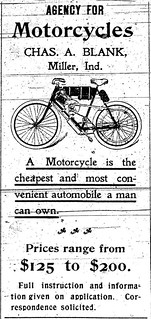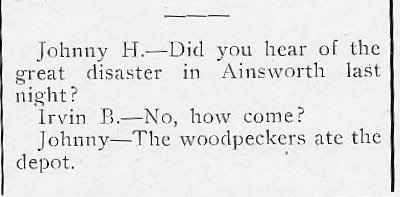In spite of the "1900" over the door of Ainsworth's original schoolhouse, I believe Jan Clemens' statement, quoted earlier, that part of the schoolhouse may have dated back as far as 1870.
My primary evidence comes from An Illustrated Historical Atlas of the State of Indiana 1876. Back in August I posted some scans of the single page I had of that Atlas. I noted that there was a house symbol where Ainsworth would be, but I didn't know what the symbol meant because I didn't have the complete Atlas with its key.
As I mentioned yesterday, since I've found the complete Atlas at the Central Library. Now I know that the little house symbol stands for a schoolhouse. So here we have a mapmaker showing a schoolhouse in Ainsworth in 1876.
My secondary evidence comes from the Hobart Gazette of June and July, 1900. on June 22, 1900, Dr. H.L. Iddings, Ross Township Trustee, published a Notice seeking bids "for the erection of a frame addition to the school building in District No. 2 (Ainsworth)." On July 20 the Gazette reported that the contract for the "new addition to the school-house" had been let. Thus the "1900" on the schoolhouse refers to the year it became a two-room schoolhouse.
It just seems to me that the wording of these items suggests that the schoolhouse had been standing for some time — otherwise, I would have expected to read something along the lines of "to expand the new schoolhouse" or "to add a room to the schoolhouse recently built." Yeah, that's pretty weak evidence. I wouldn't have mentioned it but for the Atlas. If I come up with anything better, I'll let you know.
Sources:
♦ Clemens, Jan. A Pictorial History of Merrillville. Hobart: Review Printers, Inc., 1978.
♦ "General News Items." Hobart Gazette (Hobart, Ind.) 20 July 1900.
♦ Illustrated Historical Atlas of the State of Indiana 1876. Chicago: Baskin, Forster & Co., 1876.
♦ "Notice to Contractors." Hobart Gazette (Hobart, Ind.) 22 June 1900.
Sunday, February 28, 2010
Saturday, February 27, 2010
How to Kill Yourself in Indiana in 1870
Speaking of hanging oneself, I find that it was by far the most popular form of suicide among Hoosiers in 1870. In An Illustrated Historical Atlas of the State of Indiana 1876 (Chicago: Baskin, Forster & Co., 1876), available in the Indiana Room at the Central Library, you will find a listing of deaths in Indiana in 1870, arranged by causes and ages.
Out of a total of 9,208 recorded deaths that year, 32 were suicides. Under "Accidents and Injuries," we find a listing of the methods used and the number of people who used each:
Gunshot: 7
Cutting throat: 4
Drowning: 5
Hanging: 14
Not specified: 2
And if you think I'm callous in the way I speak about suicide, you should go read the Hobart Gazette of the early 20th century. In one case that sticks in my mind, although I didn't note the exact date, the editor said, of someone's unsuccessful attempt to kill himself by cutting his own throat, "he didn't do the right kind of job."
Out of a total of 9,208 recorded deaths that year, 32 were suicides. Under "Accidents and Injuries," we find a listing of the methods used and the number of people who used each:
Gunshot: 7
Cutting throat: 4
Drowning: 5
Hanging: 14
Not specified: 2
And if you think I'm callous in the way I speak about suicide, you should go read the Hobart Gazette of the early 20th century. In one case that sticks in my mind, although I didn't note the exact date, the editor said, of someone's unsuccessful attempt to kill himself by cutting his own throat, "he didn't do the right kind of job."
ID on Mike O'Hearn?
Plodding persistence pays off. Almost a year's worth of microfilm after the Mike O'Hearn/Charles Chester face-off, I found a brief announcement that "Mike O'Hearn, the Hobart veterinarian," had married Miss Rosy Niksch. A couple of months later, Mike was running for Ross Township constable. He didn't win, however, which was probably a good thing in view of how bad he was at keeping the peace.
How many Mike O'Hearns could there have been in Hobart? It figures that he would be a pretty well known guy — the original story started off just saying, "Sunday afternoon Charley Chester … went over to the O'Hearn residence," as if all Gazette readers would know who Mike O'Hearn was and where they could find him if they wanted their arm broken.
Sources:
♦ "Democratic Ticket." Hobart Gazette (Hobart, Ind.) 17 Oct. 1902.
♦ "General News Items." Hobart Gazette (Hobart, Ind.) 16 Aug. 1901.
♦ "Local Drifts." Hobart Gazette (Hobart, Ind.) 4 July 1902.
♦ "Official Returns." Hobart Gazette (Hobart, Ind.) 7 Nov. 1902.
How many Mike O'Hearns could there have been in Hobart? It figures that he would be a pretty well known guy — the original story started off just saying, "Sunday afternoon Charley Chester … went over to the O'Hearn residence," as if all Gazette readers would know who Mike O'Hearn was and where they could find him if they wanted their arm broken.
Sources:
♦ "Democratic Ticket." Hobart Gazette (Hobart, Ind.) 17 Oct. 1902.
♦ "General News Items." Hobart Gazette (Hobart, Ind.) 16 Aug. 1901.
♦ "Local Drifts." Hobart Gazette (Hobart, Ind.) 4 July 1902.
♦ "Official Returns." Hobart Gazette (Hobart, Ind.) 7 Nov. 1902.
Friday, February 26, 2010
Henry Chester's Bad Day

From Rev. T.H. Ball, Encyclopedia of Genealogy and Biography of Lake County, Indiana (Chicago: The Lewis Publishing Company, 1904).
I don't know exactly when it happened. I don't know exactly what happened. All I know is in or around August of 1887, Henry Chester had a bad day. The evidence of it comes from the Abstract and Index to Lake County, Indiana Circuit Court Docket Book Jan. 2, 1884 – June 12, 1888 in the Lake County Central Library's Indiana Room:
Claim No.: 1333
Attorneys: Youche, J.W.
Parties: Chester, Henry
Kind of Action: Malicious Trespass
Date of Issue: Aug. 12, 1887
Claim No.: 1334
Attorneys: Youche, J.W.
Parties: Chester, Henry
Kind of Action: Drawing a dangerous weapon
Date of Issue: Aug. 12, 1887
Claim No.: 1335
Attorneys: Youche, J.W.
Parties: Chester, Henry
Kind of Action: Drawing a dangerous weapon
Date of Issue: Aug. 12, 1887
Claim No.: 1336
Attorneys: Youche, J.W.
Parties: Chester, Henry
Kind of Action: Drawing a dangerous weapon
Date of Issue: Aug. 12, 1887
Claim No.: 1337
Attorneys: Youche, J.W.
Parties: Chester, Henry; Heck, Charles; Doe, John whose name is unknown; Chester, Charles
Kind of Action: Assault & Battery
Date of Issue: Aug. 12, 1887
Henry Chester was then about 52 years old, and his son Charles, who was somehow involved in the assault and battery, about 16. I haven't been able to identify the Charles Heck involved — nor the John Doe, of course.
But were they plaintiffs or defendants? — complaining or complained of? Is the "Date of Issue" the date it all went down, or the date of the summons, or of the trial, or what?
I've been searching the 1887 newspapers and finding no mention of any affray involving these people.
The Introduction to this Abstract makes it clear that the original records behind the Docket Book have not yet been found and may well have been lost or destroyed. So, barring some miraculous discovery, we will probably never know exactly what happened on Henry Chester's bad day.
Thursday, February 25, 2010
Cold, Cold Water
Ainsworth Then and Now: Sauter's Place
Circa 1901-04 and present [updated to March 2015]
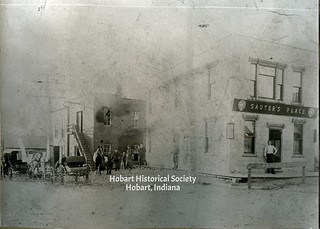
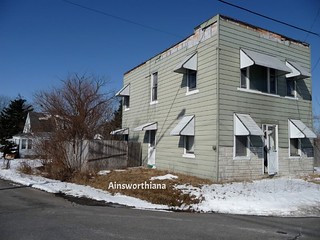
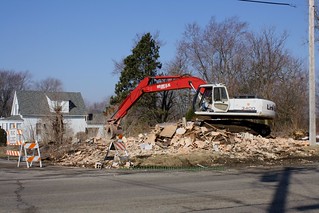
(Click on images to enlarge)
Top photo courtesy of the Hobart Historical Society
What we're looking at in the top photo is the business empire of Edward Sauter. This is the northwest corner of the intersection of State Road 51 and Ainsworth Road, just south of the Grand Trunk tracks. In the foreground is Ed's saloon, with living quarters upstairs, built in 1899. (I don't know if that guy standing in the door is Ed himself.) Immediately behind his saloon is his blacksmith shop (the brick building with the stairs going to the upper level), also built in 1899. Nestling up behind the blacksmith shop is its frame addition, built in 1901, with storage space for equipment on the lower level and a dance hall on the upper level.
Behind that is (I believe) the house still standing at 6310 Ainsworth Road. It was a one-story structure when this photo was taken; sometime in the early 1930s a second story was added. I don't know whether Ed owned it.
I will have more to say about these buildings and their history when I've finished researching them. But since my primary source of information is non-searchable microfilm, that could be many weeks.
I think Edward was the father of the George Sauter who ran a grocery store in Hobart in the 1920s — he did have a son named George, per the 1900 census. I will try to check on that.
Below is a rendering of the blacksmith shop/dance hall by artist Dale Fleming. Notecards with this illustration, and similar drawings of other local historical places, are available at the Hobart Historical Society Museum.
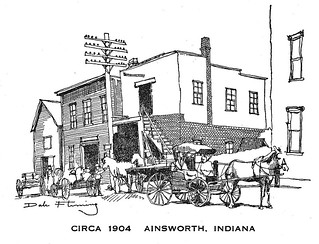
(Click on image to enlarge)



(Click on images to enlarge)
Top photo courtesy of the Hobart Historical Society
What we're looking at in the top photo is the business empire of Edward Sauter. This is the northwest corner of the intersection of State Road 51 and Ainsworth Road, just south of the Grand Trunk tracks. In the foreground is Ed's saloon, with living quarters upstairs, built in 1899. (I don't know if that guy standing in the door is Ed himself.) Immediately behind his saloon is his blacksmith shop (the brick building with the stairs going to the upper level), also built in 1899. Nestling up behind the blacksmith shop is its frame addition, built in 1901, with storage space for equipment on the lower level and a dance hall on the upper level.
Behind that is (I believe) the house still standing at 6310 Ainsworth Road. It was a one-story structure when this photo was taken; sometime in the early 1930s a second story was added. I don't know whether Ed owned it.
I will have more to say about these buildings and their history when I've finished researching them. But since my primary source of information is non-searchable microfilm, that could be many weeks.
I think Edward was the father of the George Sauter who ran a grocery store in Hobart in the 1920s — he did have a son named George, per the 1900 census. I will try to check on that.
Below is a rendering of the blacksmith shop/dance hall by artist Dale Fleming. Notecards with this illustration, and similar drawings of other local historical places, are available at the Hobart Historical Society Museum.

(Click on image to enlarge)
Labels:
Ainsworth Then and Now,
commerce,
entertainment,
Sauter
Wednesday, February 24, 2010
Train Crossing the Deep River
From today's Deep River County Park visit: an eastbound Canadian National train crossing the bridge over the Deep River as lake-effect snow falls:

(Click on image to enlarge)

(Click on image to enlarge)
Stupid Criminals: Deep River Edition
Friday, September 27, 1901, started out like any other day for William H. Wood (grandson of John), a merchant and the postmaster of Deep River — business as usual all morning in his store; then he left to take his mid-day meal, then back to the store all afternoon. But around five o'clock, he took a good look in his cash register and got a shock. A pocketbook containing some $540 in cash and checks was missing.
William must have cast his mind over all the people he'd seen in his store that day. His suspicion quickly lighted on one: James Manley, a young fellow about 17, who'd been in and out of the store during the morning. James had been in the area doing grading work on the Grand Trunk Railroad. But when William started looking for him, he was nowhere to be found.
Meanwhile, in Chicago, Mrs. Maud Adams of 728 West Madison Street got a delightful surprise. Her long-lost foster son showed up at her door. She hadn't seen James Manley in almost ten years. He'd turned out well, it seemed. He told her that he now "held a responsible position on the Grand Trunk railway" and was making good money. And it had to be true, since he showed her a fat roll of bills. She agreed to hold the money for him.
Back in Indiana, William's investigation turned up the news that James had left the Lottaville depot for Chicago that afternoon. Saturday morning William boarded a train to Chicago in pursuit. When he arrived at Dearborn Station, he must have felt somewhat at a loss among the anonymous crowds. He didn't know much about James, and beyond talking to the Chicago police, he hardly knew how to trace him. Nonetheless, he worked at it all of Saturday, then into Sunday morning. But by Sunday afternoon, with no news of the suspect, William figured he'd done all he could. He had to get home.
He headed back toward the Dearborn Station. Near the station he caught sight of a familiar face — the very man he'd just spent two days looking for. He pounced on James Manley and marched him to the central police station. From there the matter was in official hands, and by Monday evening James was in the Crown Point jail.
But why had James gone to the Dearborn Station? The answer is simple: curiosity. He really wanted to know whether anyone suspected him of the theft, so he'd been hanging around the station to see whether anyone he recognized from the Deep River area showed up.
William recovered most of his money.
Source: "Robbery at Deep River." Hobart Gazette (Hobart, Ind.) 4 Oct. 1901.
William must have cast his mind over all the people he'd seen in his store that day. His suspicion quickly lighted on one: James Manley, a young fellow about 17, who'd been in and out of the store during the morning. James had been in the area doing grading work on the Grand Trunk Railroad. But when William started looking for him, he was nowhere to be found.
Meanwhile, in Chicago, Mrs. Maud Adams of 728 West Madison Street got a delightful surprise. Her long-lost foster son showed up at her door. She hadn't seen James Manley in almost ten years. He'd turned out well, it seemed. He told her that he now "held a responsible position on the Grand Trunk railway" and was making good money. And it had to be true, since he showed her a fat roll of bills. She agreed to hold the money for him.
Back in Indiana, William's investigation turned up the news that James had left the Lottaville depot for Chicago that afternoon. Saturday morning William boarded a train to Chicago in pursuit. When he arrived at Dearborn Station, he must have felt somewhat at a loss among the anonymous crowds. He didn't know much about James, and beyond talking to the Chicago police, he hardly knew how to trace him. Nonetheless, he worked at it all of Saturday, then into Sunday morning. But by Sunday afternoon, with no news of the suspect, William figured he'd done all he could. He had to get home.
He headed back toward the Dearborn Station. Near the station he caught sight of a familiar face — the very man he'd just spent two days looking for. He pounced on James Manley and marched him to the central police station. From there the matter was in official hands, and by Monday evening James was in the Crown Point jail.
But why had James gone to the Dearborn Station? The answer is simple: curiosity. He really wanted to know whether anyone suspected him of the theft, so he'd been hanging around the station to see whether anyone he recognized from the Deep River area showed up.
William recovered most of his money.
Source: "Robbery at Deep River." Hobart Gazette (Hobart, Ind.) 4 Oct. 1901.
Tuesday, February 23, 2010
Jesse Frame: The Saga Continues
I swear I'm not stalking this guy! Can I help it if he keeps showing up in the paper?
In November of 1901 Jesse, the former night watchman, came to Hobart to visit his mother. The Gazette picked up a story he had to tell about his latest adventure.
He was working in Chicago for the Pennsylvania Railroads as a towerman (which, I gather from some hasty research, is the guy who works the levers to set the signals that tell approaching trains whether they can proceed through a railroad crossing, or whatever the case may be). While on duty on November 7, 1901, Jesse got mugged, and "relieved of his watch and chain and some small change."
I don't know what to think of this young man. First he's getting nailed up in a box, then he's taking down a thief at gunpoint, then he's losing his stuff to muggers. From victim to hero to victim. And so the wheel of fortune turns.
What I'd like to know is how the newspaper got ahold of the story. If I were Jesse, frankly, I think I'd like to keep it quiet. Did he tell his mother, and she go blabbing? Or maybe he didn't care about a tough-guy image, since it wasn't his job anymore.
Source: "Locals Drifts." Hobart Gazette (Hobart, Ind.) 29 Nov. 1901.
In November of 1901 Jesse, the former night watchman, came to Hobart to visit his mother. The Gazette picked up a story he had to tell about his latest adventure.
He was working in Chicago for the Pennsylvania Railroads as a towerman (which, I gather from some hasty research, is the guy who works the levers to set the signals that tell approaching trains whether they can proceed through a railroad crossing, or whatever the case may be). While on duty on November 7, 1901, Jesse got mugged, and "relieved of his watch and chain and some small change."
I don't know what to think of this young man. First he's getting nailed up in a box, then he's taking down a thief at gunpoint, then he's losing his stuff to muggers. From victim to hero to victim. And so the wheel of fortune turns.
What I'd like to know is how the newspaper got ahold of the story. If I were Jesse, frankly, I think I'd like to keep it quiet. Did he tell his mother, and she go blabbing? Or maybe he didn't care about a tough-guy image, since it wasn't his job anymore.
Source: "Locals Drifts." Hobart Gazette (Hobart, Ind.) 29 Nov. 1901.
Update on Jesse Frame
I gather that Jesse wasn't elected as Hobart's town marshal. He left the law-enforcement profession and went to work for the railroad (all the live-long day, just to pass the time away, one presumes). The "Local Drifts" column of the September 27, 1901 Hobart Gazette notes that several Pennsylvania Railroad employees, including "Jesse Frame … of Chicago," had paid a visit to some friends in Hobart the previous weekend.
Monday, February 22, 2010
Daily Eastbound Coal Train
I happened to be standing around with my cheap camera this afternoon when the daily eastbound coal train passed by on the Grand Trunk tracks.
Beginning of coal train:

(Click on images to enlarge)
Middle of coal train:
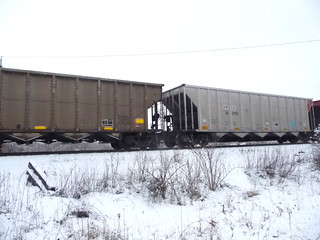
End of coal train:

Fascinating stuff, huh?
Beginning of coal train:

(Click on images to enlarge)
Middle of coal train:

End of coal train:

Fascinating stuff, huh?
Sticks and Stones Will Break My Bones
(Another Chester Family Tragedy)
On the afternoon of Sunday, August 11, 1901, Charles Chester went out on a mission: he was going to retrieve his twelve-year-old stepson from the house of one Mike O'Hearn. According to the Hobart Gazette, the boy "had been away from home about a week," which sounds as if he'd gone AWOL.
The boy in question was probably Frank Booty, who (if the 1900 census can be relied on) was twelve years old in 1901. As for this Mike O'Hearn, I haven't been able to find any official information on him.
The encounter did not go well. For reasons unknown to the Gazette, Mike grabbed a piece of wood and went on the attack, hitting Charles several times. The worst was a blow to the left arm that caused a compound fracture at the elbow.
Charles retreated to get medical attention. No word of whether the stepson came away with him.
Naturally, Charles complained to the authorities. Mike had the nerve to complain right back, saying that Charles had used profane language to him.
The profanity case against Charles came up for jury trial in the court of Justice John Mathews on September 4. After three hours of deliberations, with the votes stuck at nine for conviction, three for acquittal, the jurymen declared themselves hopelessly deadlocked and were dismissed.
The assault case against Mike was tried in Hammond on Saturday, September 7. He was found guilty. The court required him to pay a fine of $5.00, plus $20.85 in costs. Mike declared his intention to appeal to the Superior Court.
Sources:
♦ "General News Items." Hobart Gazette (Hobart, Ind.) 16 Aug. 1901.
♦ "General News Items." Hobart Gazette (Hobart, Ind.) 9 Sept. 1901.
♦ "More Swearing." Hobart Gazette (Hobart, Ind.) 13 Sept. 1901
The boy in question was probably Frank Booty, who (if the 1900 census can be relied on) was twelve years old in 1901. As for this Mike O'Hearn, I haven't been able to find any official information on him.
The encounter did not go well. For reasons unknown to the Gazette, Mike grabbed a piece of wood and went on the attack, hitting Charles several times. The worst was a blow to the left arm that caused a compound fracture at the elbow.
Charles retreated to get medical attention. No word of whether the stepson came away with him.
Naturally, Charles complained to the authorities. Mike had the nerve to complain right back, saying that Charles had used profane language to him.
The profanity case against Charles came up for jury trial in the court of Justice John Mathews on September 4. After three hours of deliberations, with the votes stuck at nine for conviction, three for acquittal, the jurymen declared themselves hopelessly deadlocked and were dismissed.
The assault case against Mike was tried in Hammond on Saturday, September 7. He was found guilty. The court required him to pay a fine of $5.00, plus $20.85 in costs. Mike declared his intention to appeal to the Superior Court.
Sources:
♦ "General News Items." Hobart Gazette (Hobart, Ind.) 16 Aug. 1901.
♦ "General News Items." Hobart Gazette (Hobart, Ind.) 9 Sept. 1901.
♦ "More Swearing." Hobart Gazette (Hobart, Ind.) 13 Sept. 1901
Sunday, February 21, 2010
I'd Like to Hear HER Side of the Story
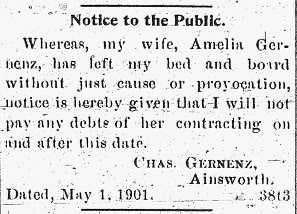
"Without just cause or provocation" — that, of course, was the legal formula, not necessarily the truth. Perhaps Charles knew in his heart she had cause. Perhaps he was the oblivious type who never thinks anything is his fault. Or perhaps his young wife had truly wronged him.
Amelia had come to the U.S. from Germany around 1893, at 15 years of age. By 17 she had married Charles Gernenz, 11 years her senior. Before she was 18 she would be a mother.
By June of 1900 she had borne two children, and was pregnant again. The house where she lived held — in addition to her four-member family — Charles' parents, Amelia's mother, and a boarder.

(Click on image to enlarge)
The Gernenz family land (outlined in red) in 1926. The parcels outlined in green had been held by Charles Gernenz' father at least since 1891.
Sometime between mid-June and early October, Amelia gave birth to a baby boy. They named him Ernest. In October, Ernest died.
Another seven months, and we have Charles' "Notice to the Public." How long, I wonder, did he wait for Amelia to come back before he published that embarrassing admission of his marital troubles?
He might have waited a little longer. She came back pretty quickly, it would seem: the 1910 census records her at home again, with three more children added to her brood — one of them, apparently, born in 1902. (For the sake of family harmony, let us hope Charles was the father.)
And she stayed. She was still with him in 1920, and the 1930 census finds them entering middle age together, with Charles, of course, well in the lead.
Sources
Friday, February 19, 2010
A Grand Trunk Hero
The Fratzke family had come to the U.S. from Germany in 1914 — just ahead of World War I. By 1920, they were renting a home in Ainsworth. The family then consisted of William Sr. (39), his wife Bertha (37), daughters Martha (14) and Hilda (13), and son William Jr. (11).
William Sr. worked as a laborer in a Grand Trunk Railroad section crew. Possibly within a few years his son had joined him on that crew, or perhaps William Jr. just felt a sort of family interest in the well-being of the railroad because of his father's work. Whatever the reason, he rendered a service to the Grand Trunk and its passengers that brought him a reward and a mention in the Hobart newspaper.
The day was November 18, 1928. William Jr. was out on the tracks west of Ainsworth when he discovered a wash-out so serious that he feared it might cause a derailment of the next passenger train, which was due through Ainsworth shortly. He hurried back to the Ainsworth depot and notified the Grand Trunk officials there, and thus the passenger train, the Hobart News said, "was probably saved from being wrecked."
There were six daily passenger trains through Ainsworth in 1928, and only one of them actually stopped. The other five were express from Valparaiso to Chicago. If the train in question had been any of those five, it would have been moving pretty swiftly when it hit the washout. And I can believe the washout was serious — you don't have to walk very far west along the tracks before you find yourself looking down a surprisingly high, steep grade into wide gullies in the landscape below.
William's reward was a $25 check from the Grand Trunk Railroad and a mention in the Hobart News. I would say also the gratitude of a trainful of passengers, but unless the conductors told them of the washout, they were probably just ticked off about the delay.
Sources:
♦ Ancestry.com. 1920 United States Federal Census [database on-line]. Provo, UT, USA: Ancestry.com Operations Inc, 2009. Images reproduced by FamilySearch. Note: Enumeration Districts 819-839 on roll 323 (Chicago City) Original data: Fourteenth Census of the United States, 1920; (National Archives Microfilm Publication T625, 2076 rolls); Records of the Bureau of the Census, Record Group 29; National Archives, Washington, D.C.
♦ Ancestry.com. 1930 United States Federal Census [database on-line]. Provo, UT, USA: Ancestry.com Operations Inc, 2002. Original data: United States of America, Bureau of the Census. Fifteenth Census of the United States, 1930. Washington, D.C.: National Archives and Records Administration, 1930. T626, 2,667 rolls.
♦ "General News Items." Hobart News (Hobart, Ind.) 24 Jan. 1929.
♦ Grand Trunk Railway System. Local Time Tables: Lines in Michigan, Indiana and Illlinois (in effect April 1, 1928).
William Sr. worked as a laborer in a Grand Trunk Railroad section crew. Possibly within a few years his son had joined him on that crew, or perhaps William Jr. just felt a sort of family interest in the well-being of the railroad because of his father's work. Whatever the reason, he rendered a service to the Grand Trunk and its passengers that brought him a reward and a mention in the Hobart newspaper.
The day was November 18, 1928. William Jr. was out on the tracks west of Ainsworth when he discovered a wash-out so serious that he feared it might cause a derailment of the next passenger train, which was due through Ainsworth shortly. He hurried back to the Ainsworth depot and notified the Grand Trunk officials there, and thus the passenger train, the Hobart News said, "was probably saved from being wrecked."
There were six daily passenger trains through Ainsworth in 1928, and only one of them actually stopped. The other five were express from Valparaiso to Chicago. If the train in question had been any of those five, it would have been moving pretty swiftly when it hit the washout. And I can believe the washout was serious — you don't have to walk very far west along the tracks before you find yourself looking down a surprisingly high, steep grade into wide gullies in the landscape below.
William's reward was a $25 check from the Grand Trunk Railroad and a mention in the Hobart News. I would say also the gratitude of a trainful of passengers, but unless the conductors told them of the washout, they were probably just ticked off about the delay.
Sources:
♦ Ancestry.com. 1920 United States Federal Census [database on-line]. Provo, UT, USA: Ancestry.com Operations Inc, 2009. Images reproduced by FamilySearch. Note: Enumeration Districts 819-839 on roll 323 (Chicago City) Original data: Fourteenth Census of the United States, 1920; (National Archives Microfilm Publication T625, 2076 rolls); Records of the Bureau of the Census, Record Group 29; National Archives, Washington, D.C.
♦ Ancestry.com. 1930 United States Federal Census [database on-line]. Provo, UT, USA: Ancestry.com Operations Inc, 2002. Original data: United States of America, Bureau of the Census. Fifteenth Census of the United States, 1930. Washington, D.C.: National Archives and Records Administration, 1930. T626, 2,667 rolls.
♦ "General News Items." Hobart News (Hobart, Ind.) 24 Jan. 1929.
♦ Grand Trunk Railway System. Local Time Tables: Lines in Michigan, Indiana and Illlinois (in effect April 1, 1928).
Thursday, February 18, 2010
Wildflowers of Ainsworth: Skunk Cabbage

(Click on images to enlarge)
Here we have skunk cabbage pushing its ugly little head up through the mud and rotted leaves next to a snowbank. I found this specimen in some swampy low ground near the Deep River.
Jack Sanders, in The Secrets of Wildflowers, has this to say about skunk cabbage:
Naturalist Neltje Blanchan described the smell [of skunk cabbage] as combining "a suspicion of skunk, putrid meat, and garlic." The scent is actually less like skunk than rotten meat or even dung. In fact, two of the scent-producing substances in skunk cabbage are skatole and cadaverine, the same chemicals found in a variety of decaying animal and vegetable matter.Perhaps that scent comes later in its development — I didn't smell any cadavers while I was photographing it. It does have a lot of development to come. These things get huge.
Here's a miniature forest of moss against the snow:
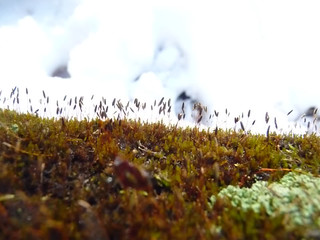
Three Nights in the Life of Jesse Frame
Here are some incidents in the life of Jesse Frame, a night-watchman in Hobart, as reported by the Hobart Gazette.
Saturday, November 18, 1899
At an evening meeting of the town board, Jesse Frame was "sworn in as a special police.... He is now clothed with authority to arrest any and all violators of the law."
Monday, January 15, 1900
About 2 o'clock in the morning, Jesse Frame surprised a thief in the act of stealing a harness from a barn being used by E.H. Guyer. Jesse drew his gun and ordered the thief to put up his hands. He complied. Jesse then marched him, along with the harness, to Mr. Guyer's house, and next to Marshal Busse, who locked him up.
♦ ♦ ♦
The last I read of Jesse Frame, he was a candidate for town marshal of Hobart. If I find out the result of the election, I'll let you know.
Sources:
♦ "Caught by Nightwatch." Hobart Gazette 19 Jan. 1900.
♦ "Local Drifts." Hobart Gazette 24 Nov. 1899.
[2/23/10 ETA: update here]
Saturday, November 18, 1899
About half a dozen of our foxy young fellows caught Jesse Frame, the night-watchman, last Saturday evening and tried to shut him up in a store box. While they were preparing to nail the box shut, they were frightened away by one of our business men…. The boys think they had lots of fun but it wouldn't have been much fun for Jesse if they had succeeded in nailing him up and in sending him away on some train.Tuesday, November 21, 1899
At an evening meeting of the town board, Jesse Frame was "sworn in as a special police.... He is now clothed with authority to arrest any and all violators of the law."
Monday, January 15, 1900
About 2 o'clock in the morning, Jesse Frame surprised a thief in the act of stealing a harness from a barn being used by E.H. Guyer. Jesse drew his gun and ordered the thief to put up his hands. He complied. Jesse then marched him, along with the harness, to Mr. Guyer's house, and next to Marshal Busse, who locked him up.
The last I read of Jesse Frame, he was a candidate for town marshal of Hobart. If I find out the result of the election, I'll let you know.
Sources:
♦ "Caught by Nightwatch." Hobart Gazette 19 Jan. 1900.
♦ "Local Drifts." Hobart Gazette 24 Nov. 1899.
[2/23/10 ETA: update here]
Wednesday, February 17, 2010
Deep River County Park: A Sign and a Critter
From today's Deep River outing:
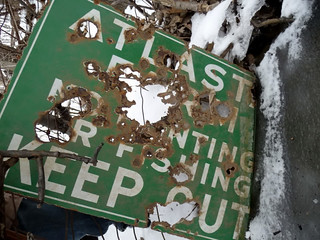
(Click on image to enlarge)
ATLAST_ FARM
NO HUNTING
OR FISHING
KEEP OUT
I can't tell what the name of the farm was, but they might as well have just called it "Unfriendly Farm." Now it's Deep River County Park, no one has to KEEP OUT and the KEEP OUT sign has fallen down and is stuck in the ice. How are the mighty fallen! I myself fell through the ice in photographing it, but fortunately I was wearing two pairs of woolen socks so my wet foot didn't freeze.
Here's a little critter who isn't very good at hiding:

(Click on image to enlarge)
I don't know what he is. He's about 12 inches from nose to tip of tail, slow on his feet, dark-furred, thin-tailed and not too bright (he thinks I can't see him!), but he seems harmless.

(Click on image to enlarge)
ATLAST_ FARM
NO HUNTING
OR FISHING
KEEP OUT
I can't tell what the name of the farm was, but they might as well have just called it "Unfriendly Farm." Now it's Deep River County Park, no one has to KEEP OUT and the KEEP OUT sign has fallen down and is stuck in the ice. How are the mighty fallen! I myself fell through the ice in photographing it, but fortunately I was wearing two pairs of woolen socks so my wet foot didn't freeze.
Here's a little critter who isn't very good at hiding:

(Click on image to enlarge)
I don't know what he is. He's about 12 inches from nose to tip of tail, slow on his feet, dark-furred, thin-tailed and not too bright (he thinks I can't see him!), but he seems harmless.
Hanged from the Rafters
Having asked around about this story, which I stumbled over in the microfilmed newspaper, I have been told that hanging oneself in the barn was a bad habit endemic to this area. I expect if I keep reading the microfilm I will encounter more such stories.
Sometimes I wonder whether I ought to write about every sensational thing I find in the old newspapers, just because it's sensational. This event, for example, happened closer to Merrillville than Ainsworth. Outside my bailiwick, perhaps. And yet no one in Ainsworth, at the time, would have drawn a line to stop news at the border of the village, or town, or township, or county. In fact the newspapers at the time reported sensational things from all over. A juicy murder or suicide or a lesser crime, if remarkable enough, anywhere in the nation or even the world could make it into the newspapers for no reason except to titillate the readers.
I'm not going to report sensational things from New York or Georgia or California, with the excuse that Ainsworth people would have read of them in the papers. But there's no point in quibbling about town limits when I'm dealing with an event that happened to neighbors.
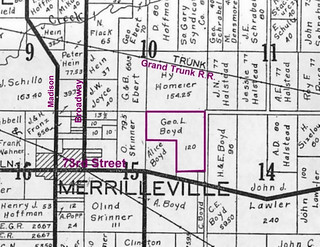
(Click on image to enlarge)
The George Boyd farm as shown on a 1926 plat book.
George and Addie Boyd owned a farm just east of Merrillville, on the north side of the Old Lincoln Highway (73rd Street). They had three daughters, Lenore, Lucille and Ellen. Around 1926, Lenore married Leo Bachelder. She was then 23 years old, he about 24. She did not have to leave her childhood home; the young couple lived with her family, while Leo commuted to his job at a steel mill in Gary.
Late in the afternoon of February 13, 1929, Leo, who worked the night shift, left for the mill with his co-worker, Edward Brackler. About an hour after they arrived at work, Leo told Edward that he wasn't feeling well and intended to go home. He left work, but he didn't go home — he went instead to a pool hall in Merrillville. He spent several hours there.
Around 11 or 11:30 that night, he finally came home to the Boyd house. Lenore was already in bed. Leo came in and spoke to her for a moment. Then he said the dogs were making noise outside and he was going to "see what was the matter with them."
Lenore fell asleep. When she awoke about 5:00 a.m. on the 14th, Leo was not in bed. She got up and looked around the house — no Leo. On the dining room table, she found some money and a piece of paper with her name in Leo's handwriting. Afraid something was seriously wrong, Lenore spread the alarm throughout the household. Everyone began looking for him.
George Boyd had already been out to the barn and not found his son-in-law there, but around 9:00 a.m. he went to the barn again. This time he happened to glance upward, and a streak of sunlight happened to be shining into the topmost part of the barn — and there George saw a body dangling from a rafter.
It was indeed the missing Leo. As far as anyone could piece events together from the scant evidence, he had gone out there shortly after speaking to Lenore. He took a flashlight — which still sat on the rafter above him — to light his way. He climbed up into the hayloft and pulled up a ladder which he then used to climb to the top of the barn. After tying a rope around the rafter and his own neck, he kicked the ladder out from under himself.
But why? No one knew of any troubles Leo had that were serious enough to drive a man to suicide. He had been a bit unwell lately, suffering from the flu — but such a mild case that he had not even been confined to bed. His wife and in-laws were mystified.
The coroner's jury returned a verdict of "suicide due to brooding over recent illness."
Lenore and Leo had no children. Lenore eventually recovered from her loss, it would seem: A Pictorial History of Merrillville, which does not mention her first marriage, tells us that she married again and went on to live a long and happy life, eventually retiring to her childhood home.
Sources:
♦ Allman Gary Title Company. Atlas and Plat of Lake County Indiana. Rockford: The Thrift Press, 1926.
♦ Ancestry.com. 1930 United States Federal Census [database on-line]. Provo, UT, USA: Ancestry.com Operations Inc, 2002. Original data: United States of America, Bureau of the Census. Fifteenth Census of the United States, 1930. Washington, D.C.: National Archives and Records Administration, 1930. T626, 2,667 rolls.
♦ Clemens, Jan. A Pictorial History of Merrillville. Hobart: Review Printers, Inc., 1976.
♦ "Leo Bachelder, of Ross Twp., Commits Suicide This Morning." The Hobart News (Hobart, Ind.) 14 Feb. 1929.
♦ "Local and Personal." The Hobart News (Hobart, Ind.) 21 Feb. 1929.
♦ ♦ ♦
The Boyd house, where these events took place, stands just east of I-65, on the north side of 73rd Street. It is a large, two-story, red brick house, still beautiful in old age.
Sometimes I wonder whether I ought to write about every sensational thing I find in the old newspapers, just because it's sensational. This event, for example, happened closer to Merrillville than Ainsworth. Outside my bailiwick, perhaps. And yet no one in Ainsworth, at the time, would have drawn a line to stop news at the border of the village, or town, or township, or county. In fact the newspapers at the time reported sensational things from all over. A juicy murder or suicide or a lesser crime, if remarkable enough, anywhere in the nation or even the world could make it into the newspapers for no reason except to titillate the readers.
I'm not going to report sensational things from New York or Georgia or California, with the excuse that Ainsworth people would have read of them in the papers. But there's no point in quibbling about town limits when I'm dealing with an event that happened to neighbors.

(Click on image to enlarge)
The George Boyd farm as shown on a 1926 plat book.
George and Addie Boyd owned a farm just east of Merrillville, on the north side of the Old Lincoln Highway (73rd Street). They had three daughters, Lenore, Lucille and Ellen. Around 1926, Lenore married Leo Bachelder. She was then 23 years old, he about 24. She did not have to leave her childhood home; the young couple lived with her family, while Leo commuted to his job at a steel mill in Gary.
Late in the afternoon of February 13, 1929, Leo, who worked the night shift, left for the mill with his co-worker, Edward Brackler. About an hour after they arrived at work, Leo told Edward that he wasn't feeling well and intended to go home. He left work, but he didn't go home — he went instead to a pool hall in Merrillville. He spent several hours there.
Around 11 or 11:30 that night, he finally came home to the Boyd house. Lenore was already in bed. Leo came in and spoke to her for a moment. Then he said the dogs were making noise outside and he was going to "see what was the matter with them."
Lenore fell asleep. When she awoke about 5:00 a.m. on the 14th, Leo was not in bed. She got up and looked around the house — no Leo. On the dining room table, she found some money and a piece of paper with her name in Leo's handwriting. Afraid something was seriously wrong, Lenore spread the alarm throughout the household. Everyone began looking for him.
George Boyd had already been out to the barn and not found his son-in-law there, but around 9:00 a.m. he went to the barn again. This time he happened to glance upward, and a streak of sunlight happened to be shining into the topmost part of the barn — and there George saw a body dangling from a rafter.
It was indeed the missing Leo. As far as anyone could piece events together from the scant evidence, he had gone out there shortly after speaking to Lenore. He took a flashlight — which still sat on the rafter above him — to light his way. He climbed up into the hayloft and pulled up a ladder which he then used to climb to the top of the barn. After tying a rope around the rafter and his own neck, he kicked the ladder out from under himself.
But why? No one knew of any troubles Leo had that were serious enough to drive a man to suicide. He had been a bit unwell lately, suffering from the flu — but such a mild case that he had not even been confined to bed. His wife and in-laws were mystified.
The coroner's jury returned a verdict of "suicide due to brooding over recent illness."
Lenore and Leo had no children. Lenore eventually recovered from her loss, it would seem: A Pictorial History of Merrillville, which does not mention her first marriage, tells us that she married again and went on to live a long and happy life, eventually retiring to her childhood home.
Sources:
♦ Allman Gary Title Company. Atlas and Plat of Lake County Indiana. Rockford: The Thrift Press, 1926.
♦ Ancestry.com. 1930 United States Federal Census [database on-line]. Provo, UT, USA: Ancestry.com Operations Inc, 2002. Original data: United States of America, Bureau of the Census. Fifteenth Census of the United States, 1930. Washington, D.C.: National Archives and Records Administration, 1930. T626, 2,667 rolls.
♦ Clemens, Jan. A Pictorial History of Merrillville. Hobart: Review Printers, Inc., 1976.
♦ "Leo Bachelder, of Ross Twp., Commits Suicide This Morning." The Hobart News (Hobart, Ind.) 14 Feb. 1929.
♦ "Local and Personal." The Hobart News (Hobart, Ind.) 21 Feb. 1929.
The Boyd house, where these events took place, stands just east of I-65, on the north side of 73rd Street. It is a large, two-story, red brick house, still beautiful in old age.
Tuesday, February 16, 2010
Telephone Snapshots
Just a couple of snapshots taken along the journey of telephone development [or insert tortured metaphor of your choice].
Here, from the Hobart Gazette of March 9, 1900, is a "list of the telephones in use at the Hobart Exchange." I'm not sure what that means, but since some of these are, for example, someone's residence, perhaps it's all the private telephones in town. Oh, and look: you can call such distant, exotic places as Ainsworth and Deep River for an additional charge.

(Click on image to enlarge.) (Sorry about the image quality, but that's how the Lake County Public Library microfilm printers print.)
Here's the sort of telephone you might have been calling on in 1900:
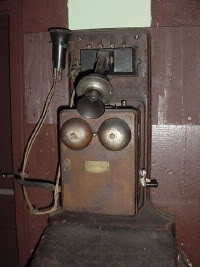
(From Northwest History Express.)
Twenty-nine years later, about half of all American households had telephones. That didn't necessarily mean their own line. In the Hobart News of June 27, 1929, Northwestern Indiana Telephone Company felt it wise to publish these rules for rural telephone subscribers, which probably included the population of Ainsworth and the farms surrounding it.
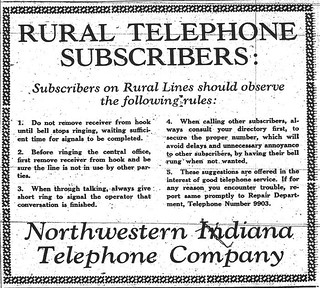
(Click on image to enlarge)
They forgot to say, "Don't listen in on other people's conversations!" That unspoken rule was sometimes violated, I am told.
Here, from the Hobart Gazette of March 9, 1900, is a "list of the telephones in use at the Hobart Exchange." I'm not sure what that means, but since some of these are, for example, someone's residence, perhaps it's all the private telephones in town. Oh, and look: you can call such distant, exotic places as Ainsworth and Deep River for an additional charge.

(Click on image to enlarge.) (Sorry about the image quality, but that's how the Lake County Public Library microfilm printers print.)
Here's the sort of telephone you might have been calling on in 1900:

(From Northwest History Express.)
Twenty-nine years later, about half of all American households had telephones. That didn't necessarily mean their own line. In the Hobart News of June 27, 1929, Northwestern Indiana Telephone Company felt it wise to publish these rules for rural telephone subscribers, which probably included the population of Ainsworth and the farms surrounding it.

(Click on image to enlarge)
They forgot to say, "Don't listen in on other people's conversations!" That unspoken rule was sometimes violated, I am told.
Monday, February 15, 2010
Ainsworth School 1900
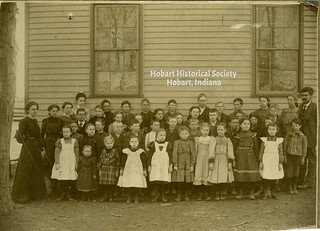
(Click on image to enlarge)
Photo courtesy of the Hobart Historical Society.
All I know about this photo is what's in the title.
Jan Clemens, in A Pictorial History of Merrillville, has this to say about the Ainsworth school:
Originally, the structure was a one room school with a fieldstone foundation that may have been erected around 1870.The same source gives the building date of the brick schoolhouse as 1912.
Sometime later, a second room was added and the newer section had a brick foundation. A coat closet separated the two rooms. There is a wooden sign on the building dating it to 1900, but the stone foundation is representative of an earlier period of time.
Sunday, February 14, 2010
Ainsworth Depot 1930
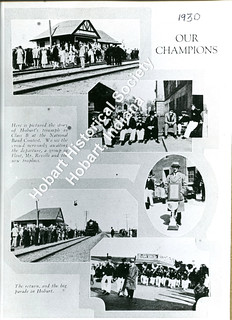
(Click on image to enlarge)
Image courtesy of the Hobart Historical Society.
"Here is pictured the story of Hobart's triumph in the Class B at the National Band Contest," says the caption, and Ainsworth had its own little part to play in that story. It was from the Ainsworth depot that the band departed, and to the Ainsworth depot they returned. A local resident who witnessed the event still recalls the hooplah of that day — the great crowd gathered around the depot to greet the conquering heroes and carry them back to Hobart in triumph.
What amazes me about the lower photo of the depot, with the steam engine, is the emptiness through which the tracks run. Nowadays there are trees all along the tracks, not to mention the Ainsworth Tower.
Saturday, February 13, 2010
Aerial Photo: 1965
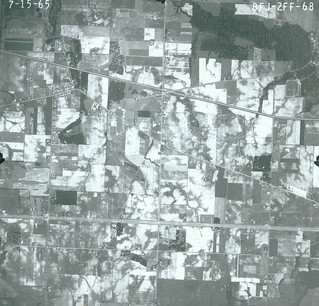
(Click on image to enlarge if you really want to, but it's a big file and not very interesting)
Photograph courtesy of the Indiana State Archives, Indiana Commission on Public Records.
Here we have Ainsworth in 1965. Not a lot has changed since 1958. A few more houses. The most notable addition is on the extreme right, about one-third of the way from the top: a big (race?)track in the area that is now the toy airplane field in Deep River County Park. No idea what, if anything, was raced there. The buildings directly north of it, whose foundations can still be seen among the trees east of Big Maple Lake, are still standing. The Ainsworth depot north of the Ainsworth Triangle seems to be gone; the little toolshed that replaced it may be there but too small to be visible. Ainsworth Road still in its old configuration, crossing the tracks. No Shilo Ranch yet.
Friday, February 12, 2010
"Kills Insane Brother in Law"
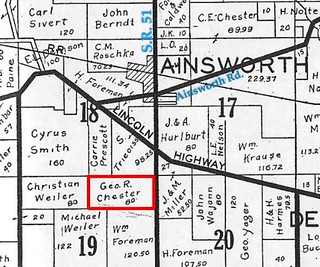
George and Ruth Chester's land is outlined in red.
(Click on image to enlarge)
George and Ruth Chester owned 80 acres of land fronting on State Road 51, just south of the old Lincoln Highway. The 1930 census recorded a small household: George, 36, working as a mechanic in a refinery; Ruth, 33, a housewife; her mother, Madeline Mack, 56; and George's brother, Frank Booty, 39 and also working in a refinery.
George and Frank had been born to Constance Booty during her first marriage. Upon her second marriage, to Charles Chester, George adopted his stepfather's surname, while Frank retained their father's.
The household was small, but it was not cozy. Frank had problems that must have made the others uneasy at times. According to Ruth, he had been "deranged" since World War I. At the war's outbreak, he had already served three years in the military and was a corporal in the artillery. Then he was sent to France where he saw heavy fighting, including poison-gas attacks. He returned from the war suffering from shell-shock — or, as we would call it, post-traumatic stress disorder.
On the morning of Monday, June 12, 1933, something went horribly wrong.
George was not home that morning — perhaps he had gone to his job at the refinery. Madeline was in the house. Ruth went out back to feed the chickens.
And Frank went "suddenly violently insane."
He first attacked Madeline with a lead pipe, breaking her arm. She escaped and fled down the road to get help. As Ruth came back into the house, Frank turned his frenzy on her, striking her in the head. She fought back and managed to push him out of the house and lock the door. Somewhere outside Frank found a heavy axe and came back swinging it. He chopped his way into a shed attached to the house, then starting battering down the house door. By now Ruth was armed, too: she had grabbed a 12-gauge shotgun kept inside the house. She brandished the gun at Frank, but he hardly seemed to notice it. He came in waving the axe, threatening to kill her. Ruth leveled the shotgun and pulled the trigger.
Later, she testified that she had meant to shoot him in the legs. In the terror of the moment, her aim was bad. The full force of the blast struck Frank in the abdomen.
He collapsed, and then seemed to come back to his senses. He was even able to speak. "I'm sorry for what I did," he said. "Get a doctor."
Ruth called neighbors, who called the Miller Clinic, but it was no use. Frank died within a matter of minutes.
Ruth was taken to Crown Point for questioning, but the Lake County Prosecutor concluded that she had clearly acted in self-defense. No charges were brought against her.
Frank was buried in the Chester Cemetery, on George and Ruth's land. The Hobart post of the American Legion held military services in his honor.
Sources
Thursday, February 11, 2010
When An Amateur Historian Has a Bad Day
Suppose you've written a stirring account of a violent death, entitled A Tragedy at Chester's Camp, based on reports from Hammond and Valparaiso newspapers. And suppose you finally track down the Hobart newspaper's version of the story on microfilm, and it says the incident didn't happen at Chester's Camp. And suppose you look at the roughly coeval non-newspaper evidence of who lived where and did what for a living (census report and plat maps), and decide the Hobart version is more credible. What does it all mean?
First, it means you have to re-write your stirring account. Secondly, it means your Chester's Camp article is now a pathetic stub, but you have to leave it where it is because you've been yammering on and on and on about Chester's Camp ever since — but you better try to gather up what random facts you've been collecting (once you remember where you put them) to fill it out more. Thirdly, it means you have to go searching through your blog looking for links that don't go to the right place anymore.
Nonetheless, I'm eternally grateful to the Hobart newspaper, because it answered a question that had been tormenting me: how could George Chester and Frank Booty be full brothers, and have different surnames? Now I understand.
And I managed to find an image of the Chester family tree:

(Photo by Nate Steiner, from Wikimedia Commons)
♦ ♦ ♦
On a lighter note, here's a picture of Maya having fun. She calls diving head-first into a pile of snow fun.
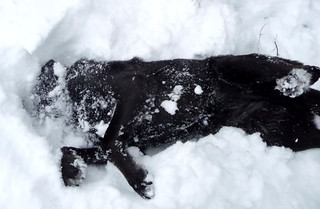
(Click on image to enlarge)
First, it means you have to re-write your stirring account. Secondly, it means your Chester's Camp article is now a pathetic stub, but you have to leave it where it is because you've been yammering on and on and on about Chester's Camp ever since — but you better try to gather up what random facts you've been collecting (once you remember where you put them) to fill it out more. Thirdly, it means you have to go searching through your blog looking for links that don't go to the right place anymore.
Nonetheless, I'm eternally grateful to the Hobart newspaper, because it answered a question that had been tormenting me: how could George Chester and Frank Booty be full brothers, and have different surnames? Now I understand.
And I managed to find an image of the Chester family tree:

(Photo by Nate Steiner, from Wikimedia Commons)
On a lighter note, here's a picture of Maya having fun. She calls diving head-first into a pile of snow fun.

(Click on image to enlarge)
Wednesday, February 10, 2010
W.G. Haan I.D.'d
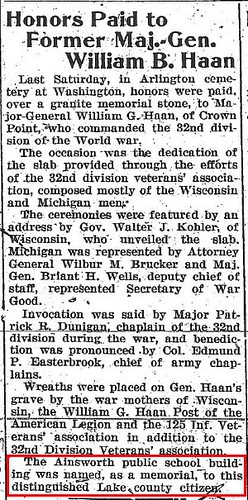
(Click on image to enlarge)
This article from the Hobart News of November 14, 1929 identifies the W.G. Haan for whom the Ainsworth school was named: "Major-General William G. Haan, of Crown Point, who commanded the 32nd division of the World war" (that is, WWI).
I'm still confused about the chronology of the building and the naming of the two school buildings.
Tuesday, February 9, 2010
Tuberculosis and the Nolte Family
Earlier I mentioned the tragic history of the Nolte family. Let me lay it out for you simply:
_______________________
*"Lung trouble."
**"Consumption."
I still haven't been able to trace Bertha beyond 1920; she may have lived to a ripe old age. The infant or child whose name is unknown died in January 1897. The newspaper notice of the burial did not give a name — a practice you sometimes see in the case of an infant or very young child. (I have not found a grave marker for this child, but I will have to go and look again when the weather gets better.)
No cause of death is given in Alvena's obituary. In a family so infected with the disease, it may well have been tuberculosis, but we just don't know. 6/28/10 update — I have come across an obituary of Henry R. Nolte that states, "All the deaths in this family have been from tuburculosis [sic]." I hesitate to accept that as a cause of the two infant deaths, but in Alvena's case it is probably true.
So that's five who died of tuberculosis in a family of ten. This brings home how real a threat it was, this disease that nobody around here gives a second thought to these days.
| Name | Cause of Death | Age at Death |
|---|---|---|
| Henry R. (father) | Tuberculosis | 59 yrs. |
| Mary (mother) | Tuberculosis* | 42 yrs. |
| William | Unknown | 1 day |
| Louisa | Tuberculosis** | 16 yrs. |
| Alvena | Tuberculosis | 15 yrs. |
| Otto | Unknown | 1.5 mos. |
| Henry T. | Gunshot wound (murder) | 45 yrs. |
| Bertha | Unknown | Unknown, but more than 28 yrs. |
| Louis | Kidney disease | 33 yrs. |
| Edward | Tuberculosis | 20 yrs. |
*"Lung trouble."
**"Consumption."
I still haven't been able to trace Bertha beyond 1920; she may have lived to a ripe old age. The infant or child whose name is unknown died in January 1897. The newspaper notice of the burial did not give a name — a practice you sometimes see in the case of an infant or very young child. (I have not found a grave marker for this child, but I will have to go and look again when the weather gets better.)
So that's five who died of tuberculosis in a family of ten. This brings home how real a threat it was, this disease that nobody around here gives a second thought to these days.
Monday, February 8, 2010
Arrested For Bastardy
Perhaps Carrie Raschka and Lovisa Nelson had to become so strait-laced just to balance out the antics of their stepbrothers: Exhibit A was John Chester's Prohibition troubles; now I've found Exhibit B in the form of a Hobart Gazette article from July 31, 1908, delicately entitled: "Arrested For Bastardy."
On July 27, 1908, a woman by the name of Mary Kovanek, age unknown, Bohemian by birth, filed a complaint against Jerome Chester alleging that he was the father of the child born to her on February 28, 1908.
She had been hired by Henry and Mary Chester as a live-in domestic beginning in mid to late May 1907. Jerome was then about 27 years old, unmarried, still living with his parents. She remained with the Chesters no more than two months. During that time, she said, Jerome "visited her room" on several occasions.
Mary left the Chester household on July 16, 1907, and was married to Mr. Kovanek the following day. Seven-and-a-half months later, she gave birth to a child. (She already had another "fatherless" child about four years old.)
She claimed that Jerome had earlier acknowledged his responsibility, and given her a little money now and then, but by July 1908 he had so completely reneged on his promise to support the child that she was obliged to file the complaint. The Kovaneks were in financial straits and needed the money.
Jerome was arrested the same day and brought in for a hearing before Judge Mathews. (My reading of the article is that the hearing took place in Hobart, but it isn't clear.) Attorney R.R. Peddicord argued the state's case; Jerome was defended by F.T. Fetterer and W.W. Bozarth. Witnesses included Dr. Mackey, who delivered the baby, and Drs. Bulhand and Gordon, expert witnesses on "evidence concerning maternal cases." Both sides gave spirited arguments, and the hearing carried over into the following day. At the end of it, however, Judge Mathews found Jerome not guilty.
The large crowd attending the hearing was outraged. As word of the verdict spread, so did the scandal. The Gazette said, "This community is almost of one opinion and firm in the belief that this poor, ignorant mother, who belongs to that race of people who are taught from infancy to obey their masters, told the plain, cold facts, uncolored and uncoached." (Again I find myself surprised: I wouldn't have thought people in 1908 would be so sympathetic towards a woman who admitted to being the mother of two illegitimate children.)
On the evening of July 29, R.R. Peddicord went to Hammond to pursue Mary's case with City Judge McMahan. The judge issued a warrant for Jerome's re-arrest, and before dawn on the 30th, Jerome was again in the hands of the law — riding the early Nickel Plate train to a new hearing in Hammond.
There, Judge McMahan "decided that Chester was the father of the child and bound him over to the superior court in the sum of $300 bonds, which were furnished. The case will probably come up for trial at the September term."
I have been searching the Gazette and other 1908 papers for follow-up reports, but I haven't found any.
Weren't things complicated before we developed the science of DNA?
[4/6/2010: Update here.]
On July 27, 1908, a woman by the name of Mary Kovanek, age unknown, Bohemian by birth, filed a complaint against Jerome Chester alleging that he was the father of the child born to her on February 28, 1908.
She had been hired by Henry and Mary Chester as a live-in domestic beginning in mid to late May 1907. Jerome was then about 27 years old, unmarried, still living with his parents. She remained with the Chesters no more than two months. During that time, she said, Jerome "visited her room" on several occasions.
Mary left the Chester household on July 16, 1907, and was married to Mr. Kovanek the following day. Seven-and-a-half months later, she gave birth to a child. (She already had another "fatherless" child about four years old.)
She claimed that Jerome had earlier acknowledged his responsibility, and given her a little money now and then, but by July 1908 he had so completely reneged on his promise to support the child that she was obliged to file the complaint. The Kovaneks were in financial straits and needed the money.
Jerome was arrested the same day and brought in for a hearing before Judge Mathews. (My reading of the article is that the hearing took place in Hobart, but it isn't clear.) Attorney R.R. Peddicord argued the state's case; Jerome was defended by F.T. Fetterer and W.W. Bozarth. Witnesses included Dr. Mackey, who delivered the baby, and Drs. Bulhand and Gordon, expert witnesses on "evidence concerning maternal cases." Both sides gave spirited arguments, and the hearing carried over into the following day. At the end of it, however, Judge Mathews found Jerome not guilty.
The large crowd attending the hearing was outraged. As word of the verdict spread, so did the scandal. The Gazette said, "This community is almost of one opinion and firm in the belief that this poor, ignorant mother, who belongs to that race of people who are taught from infancy to obey their masters, told the plain, cold facts, uncolored and uncoached." (Again I find myself surprised: I wouldn't have thought people in 1908 would be so sympathetic towards a woman who admitted to being the mother of two illegitimate children.)
On the evening of July 29, R.R. Peddicord went to Hammond to pursue Mary's case with City Judge McMahan. The judge issued a warrant for Jerome's re-arrest, and before dawn on the 30th, Jerome was again in the hands of the law — riding the early Nickel Plate train to a new hearing in Hammond.
There, Judge McMahan "decided that Chester was the father of the child and bound him over to the superior court in the sum of $300 bonds, which were furnished. The case will probably come up for trial at the September term."
I have been searching the Gazette and other 1908 papers for follow-up reports, but I haven't found any.
Weren't things complicated before we developed the science of DNA?
[4/6/2010: Update here.]
Sunday, February 7, 2010
Alex's Place
I just had brunch at Alex's Place in the old Ainsworth School building. I had the spinach-and-feta omelette. They use fresh spinach — yummy! The breakfast-and-lunch dining room is on the lower level, where the cafeteria was when the building was used as a school. I think the Friday night fish fries are held upstairs, but I've never actually been to one.
Saturday, February 6, 2010
An Update to Ainsworth School
At the Hobart Historical Society Museum this morning, I came across an Ainsworth school program dating to the same year as the photo, so I updated my earlier post with some names to go with the photo.
Friday, February 5, 2010
Brenda Starr at Hobart High: Dale Messick's Aurora Artwork
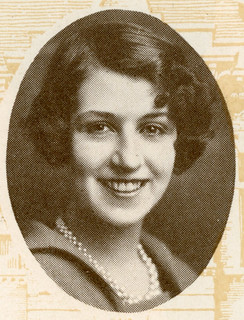
(Click on image to enlarge)
Dale Messick as a senior at Hobart High School, 1926
You wouldn't guess from her thousand-watt smile that Dalia Messick found high school "boring" — or so she told an interviewer 75 years later, when she was Dale Messick, the legendary creator of Brenda Starr, Reporter. But throughout her high-school career and for at least a year afterward, she contributed numerous cartoons and illustrations to Hobart High School's yearbook, the Aurora. And looking at her charming Aurora artwork today, I get the impression that she was having fun with that, at least.
Dalia, Dale and Brenda
Dalia was born in South Bend, Indiana, on April 11, 1906, to parents who both had a creative streak. Her mother was a milliner or seamstress, her father a sign painter. At a very young age she showed artistic talent, and her father encouraged her to develop it. The family later moved to Hobart.
By the seventh grade, Dalia was entertaining her Hobart classmates with story-strips that she wrote and illustrated. Then came high school and the Aurora. Dalia graduated in 1926, but the 1927 yearbook is full of her artwork.
After high school, she studied commercial art in Chicago, at the Art Institute and Rays Commercial Art School. She would go on to work for various engraving companies, in Chicago, Cleveland and New York, primarily in the design and illustration of greeting cards.
That was her day job and the way she supported her parents and siblings during the Depression; at night she worked on her comic strips. Meanwhile, she managed to get some single-panel comics printed in various Eastern newspapers.
Her first attempt at a commercial comic strip was a failure. Called Steamline Babies, it featured two young women seeking fame and fortune in New York. Dalia was devastated when the McNaught Syndicate rejected it. She picked herself up and went back to the drawing board.
Her big break came with Brenda Starr, Reporter, but that break almost didn't happen. The Washington Post tells the story like this:
Ms. Messick had to fight her way into funny papers at the beginning, when editors would rather take her to lunch than take her work seriously. Mollie Slott, then secretary to the head of the Chicago Tribune-New York News Syndicate, recovered Ms. Messick's strip from an office trash can and persuaded Ms. Messick to change Brenda's occupation from bandit to reporter. She also suggested Ms. Messick change her given name from Dalia to Dale to get around the blatant sexism of the time.Brenda Starr debuted in newspapers in June 1940. Within a couple of weeks, the local papers had been alerted to the fact that Dalia and Dale were one and the same. The Hammond Times urged readers to send letters to the Tribune supporting the local girl's comic strip.

(Click on image to enlarge)
The debut of Brenda Starr, Reporter (from Dougsploitation).
Letters or not, the strip caught on with the reading public in a big way. At the peak of its popularity, Brenda Starr appeared in 250 newspapers. It has continued to run since 1940; after Messick's retirement, the strip has been written and illustrated by other women.
Dale Messick died April 5, 2005, at the age of 98.
She had not been the first female comic-strip artist/writer, but Brenda Starr was groundbreaking. It featured a smart, independent career woman who actively sought equal treatment with her male colleagues. Its combination of adventure, fashion and romance gave the strip wide appeal and brought this modern heroine into homes all across the country.
The Aurora Artwork
As a freshman at Hobart High School, Dalia created an illustration for each section of the 1923 yearbook — "Faculty," "Seniors," "Music," "Sports," and so on. The drawings were a bit rough, as might be expected in an amateur artist of sixteen, but she showed promising skill and imagination:
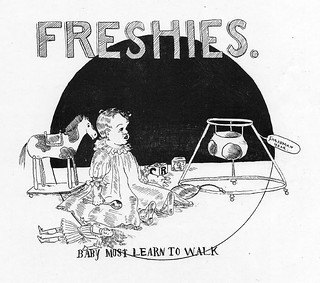
(Click on images to enlarge)
For some reason she did not contribute to the 1924 yearbook. In 1925 she was back, however, and two years' practice had honed her skills. In this cartoon illustration, she gently poked fun at the peculiarities of various faculty members:
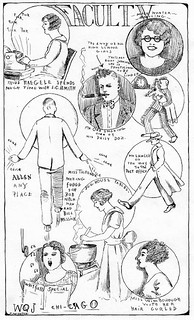
In her senior year, Dalia again contributed section illustrations, by now considerably more polished and complex than the earlier drawings:
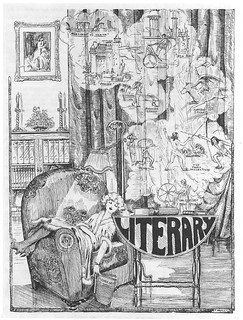
She also created "Minute Novels," as she called them — story strips capturing the hijinks of, for example, the typical sophomore:
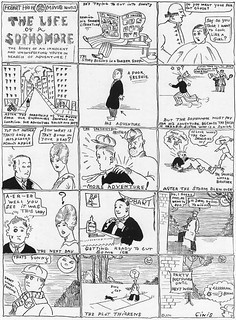
In 1927, although no longer a student, Dalia illustrated the yearbook. The entire book was printed on a background of her art. Her section illustrations had by now reached a level of sophistication miles beyond her debut:

There were no "Minute Novels" this year, only tiny cartoons throughout the "Timekeeper" section (a daily chronicle of the school year). Here, her commentary characters disagree on the yearbook's quality:

And here she gives us a glimpse of herself at work:

If any of the artwork in the 1928 yearbook is hers, it is unsigned and so polished that her personal style is no longer recognizable.
All of the yearbooks excerpted here can be examined more fully at the Hobart Historical Society Museum (706 E 4th St., Hobart, IN 46342, (219) 942-0970; open Saturdays from 10 a.m. to noon).
Sources:
♦ "Artist Is Hobart Product." Hammond Times (Hammond, Ind.) 15 Jul. 1940.
♦ "Hobart Girl Writing Comic Strip in Chicago Newspaper." Hobart Gazette (Hobart, Ind.) 11 Jul. 1940.
♦ Leger, Jackie. "Dale Messick: A Comic Strip Life." Animation World Magazine, July 2000 (http://www.awn.com/mag/issue5.04/5.04pages/legermessick.php3).
♦ Prinzivalli, Doug. "Brenda Starr, Reporter." Dougsploitation. http://dougsploitation.blogspot.com/2009/04/brenda-starr-reporter.html (accessed 5 Feb. 2010).
♦ Sullivan, Patricia. "Cartoonist Dale Messick Dies; Creator of 'Brenda Starr' Strip. Washington Post 8 Apr. 2005 (http://www.washingtonpost.com/wp-dyn/articles/A35837-2005Apr7.html).
Thursday, February 4, 2010
THAT'S NOT FUNNY!!!
Wednesday, February 3, 2010
The Masked Bandit of Deep River
Close encounters of the furred kind in Deep River County Park today.
The evidence:

(Click on images to enlarge)
The suspect:

The suspect eluded pursuit. He climbed another three feet up, and disappeared into a hole in the tree trunk about 40 feet off the ground. Obviously a member of the Hole-in-the-Tree Gang.
The evidence:

(Click on images to enlarge)
The suspect:

The suspect eluded pursuit. He climbed another three feet up, and disappeared into a hole in the tree trunk about 40 feet off the ground. Obviously a member of the Hole-in-the-Tree Gang.
Grand Trunk Western Railroad Employees Timetable 1939
Grand Trunk Railroad Employees Timetable 1939
No stop at Ainsworth. That does it, I'm not buying any more post-1938 timetables. Too much heartache.
No stop at Ainsworth. That does it, I'm not buying any more post-1938 timetables. Too much heartache.
Tuesday, February 2, 2010
Gee, I Wonder Why
The "Local and Personal" column of the Hobart News of November 24, 1927, carried a tantalizing item. The Shults* family, it said, had moved to a farm south of Merrillville after selling their land along the Lincoln Highway west of Deep River to an unnamed person from Chicago. The News said, "It was stated at the time [of the sale] that the farm was to be used as a golf grounds for a negro golf club of Chicago, although the deal was made by a white man. It was said the deal with the golf club fell through."
I wonder whether the fact that the deal "fell through" had anything to do with the strong Klan presence in the area in the 1920s. As we've seen, you could get a crossed burned on your lawn in Ainsworth just for being Catholic. The Klan in Hobart held open festivities such as the Labor Day picnic and parade, and the 1927 papers carried routine announcements of parties at "Klan hall."
I don't think I need to provide a cite for the proposition that black people would have been barred from joining local country clubs or playing on local golf courses in the 1920s, hence the need to form a "negro golf club." But I expect the Klan would have viewed even a segregated golf club as an invasion.
We'll never know for sure why the deal fell through. It's a pity it did — a black golfers' club would have been an interesting addition to local history.
________________________
I haven't been able to figure out which Shults household this was. There were several in the area between 1920 and 1930.
I wonder whether the fact that the deal "fell through" had anything to do with the strong Klan presence in the area in the 1920s. As we've seen, you could get a crossed burned on your lawn in Ainsworth just for being Catholic. The Klan in Hobart held open festivities such as the Labor Day picnic and parade, and the 1927 papers carried routine announcements of parties at "Klan hall."
I don't think I need to provide a cite for the proposition that black people would have been barred from joining local country clubs or playing on local golf courses in the 1920s, hence the need to form a "negro golf club." But I expect the Klan would have viewed even a segregated golf club as an invasion.
We'll never know for sure why the deal fell through. It's a pity it did — a black golfers' club would have been an interesting addition to local history.
________________________
I haven't been able to figure out which Shults household this was. There were several in the area between 1920 and 1930.
Monday, February 1, 2010
So, How'd that Tuf Tread Work Out for Ya?
When last we spoke of State Road 51, the year was 1927, and S.R. 51, an unpaved road that caused many motorists to come to grief in the springtime, was about to receive a coating of Tuf Tread, which we can surmise was crushed gravel.
By the spring of 1928, motorists were again coming to grief on S.R. 51, and the Hobart News indignantly entitled an article, "Tuf Tread Roads Only a Waste of People's Money," and described the almost impassable condition of the Tuf Treaded road at times:
Source: "Tuf Tread Roads Only a Waste of People's Money." Hobart News (Hobart, Ind.) 5 Apr. 1928.
By the spring of 1928, motorists were again coming to grief on S.R. 51, and the Hobart News indignantly entitled an article, "Tuf Tread Roads Only a Waste of People's Money," and described the almost impassable condition of the Tuf Treaded road at times:
In this stretch of road [between Hobart and the Lincoln Highway] within a couple of miles there appear to be stretches of quicksand or springs underlying the roadway, where for perhaps fifty feet at a stretch the bottom seems to go out, leaving the road in very bad condition.It would continue in that condition for several years more, and there would be much grief on S.R. 51.
Source: "Tuf Tread Roads Only a Waste of People's Money." Hobart News (Hobart, Ind.) 5 Apr. 1928.
Subscribe to:
Posts (Atom)

